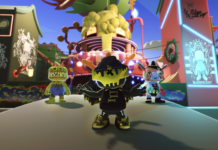Every sandbox game or level editor strikes a different balance between satisfying gameplay and creative freedom. In Minecraft, you can recreate the Eiffel Tower out of blocks, or spend hours digging, exploring, and surviving. Other games lean toward one side or the other. Halo 4 lets you create your own maps, but the tools and limits on them are very strict since the focus is on sharp FPS gameplay. LittleBigPlanet lets you make a ton of different types of games, but doesn’t offer the kind of platforming polish you’d get in, say, a Nintendo game. Now there’s a new entry in the genre, with a new goal: why try to strike a balance or make sacrifices when you can just have it all?
UemeU is dubbed by developer Omnigon games as a next generation sandbox game, and to live up to that moniker they are coming at it with some lofty goals. On the creation side, players are greeted with an intuitive interface for making just about whatever they want and having it interact with the rest of their world however they please. On the gameplay side, the in-progress version of UemeU I saw was akin to a third-person shooter — but that’s just the tip of the iceberg.
Any one aspect of UemeU will take a bit of time to explain, but for my money the idea is closest to Halo’s Forge mode on a much larger scale. You have the ability to bounce between build mode and play mode on a whim. Build mode is represented by a floating, omnipotent hand; while play mode is represented by your avatar. A server can have a mix of players building and playing, and the result is not unlike Halo’s 8-player online level creation tool. You can even share your creations through a database with other players, but again, compared to Halo’s sharing of custom maps and gametypes, UemeU is on a much grander scale.

Consider this potential anecdote: You approach UemeU for the first time with the goal of recreating the original Resident Evil. Your first goal may be to get a working gun and zombie. You may be dedicated enough to handcraft the gun by combining and resizing simple shapes in the editor mode, but chances are there will already be dozens, if not hundreds or even thousands of working guns already available in UemeU’s database. These guns will be tagged and rated by the community, and even curated in a list of top content. You could give the gun the correct properties to fire bullets a particular way, but again, someone probably already did that job for you.
From there you can grab a suitable zombie from the database, complete with proper AI. Perhaps you’ll have to go in and tweak it to get that perfect Resident Evil-style chewing animation, but most of the work will be done already thanks to the community. The team at Omnigon provides the verbs, like an AI “follow” behavior, and leaves it up to players to craft a zombie or alien or a clown car on fire. They provide tools to match the commands and actions to your creations, allowing creators to upload things like working doors into the database for other people to use. “When someone comes on for the first time, without even knowing how to use all of the advanced tools, we’ll be showing them an interface much more like The Sims,” said Omnigon CEO Jeremy Hindle during my preview.
In the demo version of the game, which is available now in early access fashion for about $19, players and creators are limited to 10-player multiplayer in 1-square-mile worlds without saving. However, the plan for the final game is to let players craft custom biomes in an infinitely and randomly generated world. You may want a great pyramid or special dungeon that only appears once in the world, or a selection of buildings that can randomly generate a city biome. Presumably, adventurous players could make something like No Man’s Sky in UemeU. “We obviously watched all the E3 stuff, and I was just like, ‘Yeah we’ve got that.’ We can already do a lot of that in our game,” Hindle told me.

Omnigon expects that the majority of UemeU players will spend most of their time playing and browsing other creator’s content. So what do you do in someone else’s infinite, randomly-generated world? This is the one aspect of UemeU that Omnigon seems the least clear on at this point, but they have a strong design goal in mind. At the core is an over-the-shoulder third person perspective, along with the ability to aim, jump, double-jump, wall-run, and roll in any direction. An avatar can have four different abilities, with the flexibility to combine two or more abilities from a pool of hundreds. Hindle made their ambition for the ability system clear: “Think, every ability in every MOBA, plus things you can think of from anime, plus things you can think of from other games.”
The resulting blend of abilities and third-person perspective is a bit like Mass Effect combined with the agility aspects of Titanfall. The deathmatch map they showed me allowed players to turn invisible, reveal other invisible players, and shoot, all while wall-running and jumping around. It all feels a bit early, but there’s some momentum to account for and enough skill in navigating to make for an enjoyable experience. But again, that’s just the tip of the iceberg for play mode.
“We had a whole hand-to-hand combat system just like Dark Souls…we decided it wasn’t fun so we took it out,” Hindle explained. “Instead we’re going to go for something more Smash Bros.-like.” He went on to describe ragdoll physics for big hits and the ability to create weapons, map them to an avatar’s hands, and through inverse kinematics tech, have the weapon behave and animate as it should. Later on, they pulled a jet into the world that Hindle had made months ago, and got it flying around the environment. The plan, as development continues, is to create satisfying mechanics for each style of gameplay the community may want.

There’s even the potential for gametypes that blend both the build mode and the play mode. Imagine, for example, a group of players attempting to navigate a maze of traps that the builder is crafting on the fly. In another anecdote, a member of the community asked Omnigon if the game would meet their needs for a Dungeon’s & Dragons campaign, and the team got to work on making that a viable option. Omnigon hopes to give players as much freedom as possible, but always offer a more polished and balanced option where they can.
Ultimately I think that may be what sets UemeU apart from the Unity engine it’s built upon. You could argue that with this much freedom, players may as well just learn how to program and design their own games. UemeU seems to be offering that kind of freedom, but without the technical headaches of a programming language or complex math. In addition, it will be the crafted aspects of the first full release that will ensure UemeU is a true sandbox game and not a tool. What they’re going for sounds impossibly ambitious, but they’re already off to a good start. Its name might not roll off of the tongue, but I think UemeU will be talked about for a long time to come.
Enjoy random thoughts about the latest games, the Sega Saturn, or the occasional movie review? Follow me @JoeDonuts!










